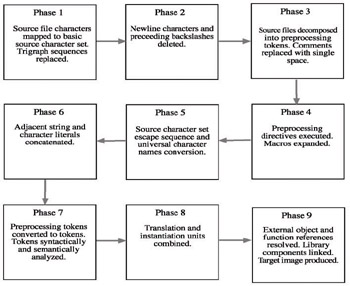Chapter 5
|
| < Day Day Up > |
|
Chapter 4
-
List at least five components of a typical computer system.
System unit, speakers, monitor, hard disk drive, floppy disk drive, memory, etc....
-
What device do the peripheral components of a computer system exist to support?
Processor or Microprocessor
-
From what two perspectives can programs be viewed? How does each perspective differ from the other?
The computer perspective and the human perspective
-
List the nine phases of the C++ translation process.

-
What are the function of trigraphs?
Trigraphs are used by programmers to write source code on terminals that lack the special characters required by the basic source character set.
-
What is a C++ translation unit?
A translation unit consists of a source file, its headers and any source files included via the #include preprocessor directive, minus any source lines skipped by conditional compilation.
-
List and describe the four steps of the processing cycle?
Fetch - Fetch an instruction from memory
Decode - Translate the instruction into electronic signals that control the processor
Execute - Carry out the operations required by the instruction
Store - Store the results of the instruction in memory
-
State in your own words the definition of an algorithm.
A recipe for solving a problem.
-
How does a processor's architecture serve to implement its feature set?
A processor's architecture dictates what features the processor offers.
-
How can programmers access a processor's feature set?
Via the processor's assembly language.
|
| < Day Day Up > |
|
EAN: 2147483647
Pages: 340